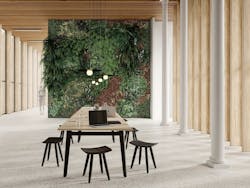Tables hold a special place in design. Like a bridge, they’re designed to bring people together, allowing them to mingle and mix at their own speed. A table anchors a room, becoming part of the infrastructure that allows people to do their best work.
Fixed, a new table by Leland Furniture, embodies that spirit. This large collaborative table is inspired by the beauty and strength of Michigan’s many bridges and serves as a destination for individuals or small groups.
“What’s interesting about bridges is that there’s a philosophical take of how bridges bridge people together, so they’re a landmark that brings people from A to B and allows them to mix, but aesthetically bridges have a kind of gravity to them,” explained Justin Burton, designer at 2B Studio, a design firm that frequently collaborates with Leland. “They’re built into the landscape, so they become almost like monuments where their beauty is in their honesty.”
Tables serve a similar role, Burton said. They blend into the environment they’re in while serving as a visual anchor for a room.
[Related: SiS Ergo’s New Height-Adjustable Work Desk is Ideal for a Post-Pandemic Workspace]
Interior Infrastructure
Like the bridges that inspired its design, Fixed is very much designed to serve a purpose. The sheet metal legs are hollow, allowing users to instinctively route power down through the leg and out to the wall.
“We really wanted power to be integral to this, not just an afterthought,” Burton said. “It’s an honest and intuitive take on that, where you don’t have to do this convoluted wire chase or take the whole table apart to get the power out. It installs very quickly, it’s reconfigured very quickly and it celebrates that power.”
The sheet metal itself is also a nod to Michigan, Burton added, because the state’s manufacturing capabilities include a considerable amount of sheet metal processing. “It’s one of our strengths,” he said. “As an industrial designer, you’re always trying to push the bounds of the material and get it to do new things. With some of the capabilities in sheet metal today, it’s more than just this fabricated, engineering-driven thing.”
The curve of the leg’s exterior appears soft, almost like a Scandinavian-style form, Burton said. But the softness actually creates strength.
“It’s like origami,” Burton explained. “Every time you fold sheet metal, you can do so in a way that makes it stronger. Bridges use the same engineering principle. By forming the leg in that way, not only does it allow you to route power down through the leg, but it makes the sheet metal leg stand stronger than it would if it was flat. It’s doing this clever double duty.”
How to Specify Fixed
The table is available in heights of 29, 36 or 42 inches, making it an ideal height for standing meetings or, in the case of the tallest version, bar-height seating. Designers can choose from circular, square or rectangular shapes; four edge options; a wide variety of top sizes; and tops of high-pressure laminate, Forbo or Corian.
“It scales really easily,” Burton said. “The primary application is seating areas and informal meeting spaces. In its largest format, it has this sense of weight and gravity, so it creates an anchor in the space… Collaboration is probably the biggest driver, especially considering the power integration.”
Rectangle tables also have the option of a storage caddy, giving the table additional versatility.
Specifying the table for a collaborative space? Fill the caddy with markers, sticky notes or scratch paper. Using it for hospitality instead? The caddy is perfect for extra napkins. Or, alternatively, store extra chargers and cords to complement the access to power.
These flexible options give specifiers the tools to create different experiences for clients, Burton noted. End users can stand, sit, collaborate or work alone. An adaptable table like Fixed can accommodate multiple work modes and user preferences.
“The table says a lot of things,” Burton said. “It’s where we eat, where we work, where we create. It’s just a flat, planar surface that allows us to do work at our level. The reason the tables are the anchor of the room is that’s where the work is being done. A chair supports you, but a table supports creation. The table is what allows us to expand the human experience.”
Read next: Raised Flooring Gets a Biophilic Boost
About the Author
Janelle Penny
Editor-in-Chief, BUILDINGS
Janelle Penny is a senior writer for i+s and is Editor-in-Chief of BUILDINGS. She has more than a decade of experience in journalism, with a special emphasis on covering facilities. She aims to deliver practical, actionable content for her readers.

